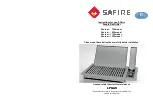
6
Additional power tool safety warnings
Warning!
Additional safety warnings for drills
♦
Wear ear protectors when impact drilling.
Exposure
to noise can cause hearing loss.
♦
Use auxiliary handles supplied with the tool.
Loss of
control can cause personal injury.
♦
Brace the tool properly before use.
This tool produces
a high output torque and without properly bracing the
tool during operation, loss of control may occur resulting
in personal injury.
♦
Hold power tool by insulated gripping surfaces
when performing an operation where the cutting
accessory may contact hidden wiring.
Cutting
accessory contacting a “live” wire may make exposed
metal parts of the power tool “live” and could give the
operator an electric shock.
♦
Hold power tool by insulated gripping surfaces,
when performing an operation where the fastener
may contact hidden wiring.
Fasteners contacting a
“live” wire may make exposed metal parts of the power
tool “live” and could give the operator an electric shock.
Safety instructions when using long drill bits
♦
Never operate at higher speed than the maximum
speed rating of the drill bit.
At higher speeds, the
bit is likely to bend if allowed to rotate freely without
contacting the workpiece, resulting in personal injury.
♦
Always start drilling at low speed and with the bit
tip in contact with the workpiece.
At higher speeds,
the bit is likely to bend if allowed to rotate freely without
contacting the workpiece, resulting in personal injury.
♦
Apply pressure only in direct line with the bit and
do not apply excessive pressure. Bits can bend
causing breakage or loss of control, resulting in
personal injury.
♦
Use clamps or another practical way to secure and
support the workpiece to a stable platform.
Holding
the work by hand or against your body leaves it unstable
and may lead to loss of control.
♦
Before drilling into walls, floors or ceilings, check
for the location of wiring and pipes.
♦
Avoid touching the tip of a drill bit just after drilling,
as it may be hot.
♦
The intended use is described in this instruction
manual.
The use of any accessory or attachment or
performance of any operation with this tool other than
those recommended in this instruction manual may
present a risk of personal injury and/or damage to
property.
Safety of others
♦
This tool is not intended for use by persons (including
children) with reduced physical, sensory or mental
capabilities, or lack of experience and knowledge,
unless they have been given supervision or instruction
concerning use of the tool by a person responsible for
their safety.
♦
Children should be supervised to ensure that they do not
play with the appliance.
Residual risks
Additional residual risks may arise when using the tool which
may not be included in the enclosed safety warnings. These
risks can arise from misuse, prolonged use etc.
Even with the application of the relevant safety regulations
and the implementation of safety devices, certain residual
risks can not be avoided. These include:
♦
Injuries caused by touching any rotating/moving parts.
♦
Injuries caused when changing any parts, blades or
accessories.
♦
Injuries caused by prolonged use of a tool. When using
any tool for prolonged periods ensure you take regular
breaks.
♦
Impairment of hearing.
♦
Health hazards caused by breathing dust developed
when using your tool (example:- working with wood,
especially oak, beech and MDF.)
Vibration
The declared vibration emission values stated in the
technical data and the declaration of conformity have been
measured in accordance with a standard test method
provided by EN 62841 and may be used for comparing one
tool with another. The declared vibration emission value may
also be used in a preliminary assessment of exposure.
Warning!
The vibration emission value during actual use of
the power tool can differ from the declared value depending
on the ways in which the tool is used. The vibration level may
increase above the level stated.
When assessing vibration exposure to determine safety
measures required by 2002/44/EC to protect persons
regularly using power tools in employment, an estimation of
vibration exposure should consider, the actual conditions of
use and the way the tool is used, including taking account of
all parts of the operating cycle such as the times when the
tool is switched off and when it is running idle in addition to
the trigger time.
Labels on tool
The following symbols are shown on the tool along with the
date code:
(Original instructions)
ENGLISH






























